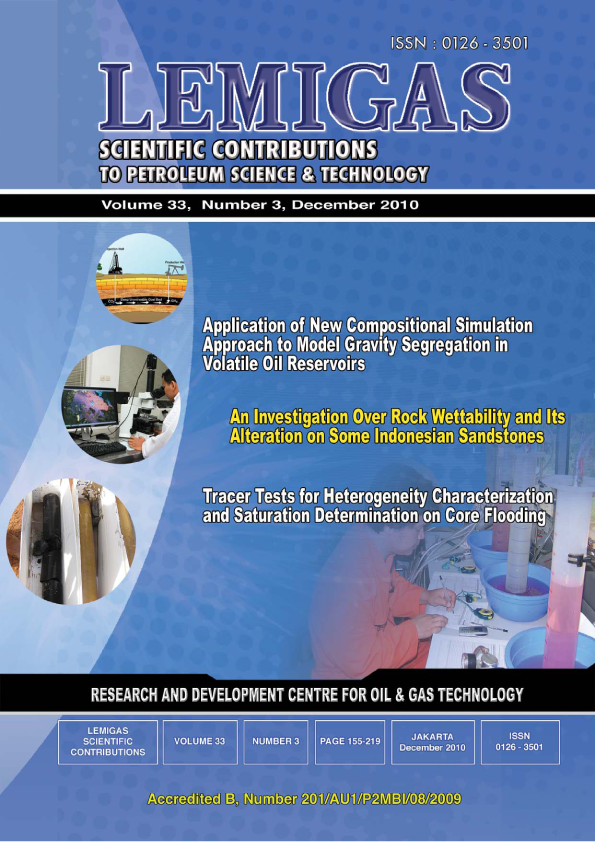Application of New Compositional Simulation Approach to Model Gravity Segregation In Volatile Oil Reservoirs
DOI:
https://doi.org/10.29017/SCOG.33.3.661Keywords:
compositional, equation of state, gravity segregation, volatileAbstract
In this paper, we investigate the recovery performance of gas injection from volatile oil
reservoirs. Cross-sectional reservoir studies for investigating the gravity segregation during
depletion and gas cycling in volatile oil reservoirs is discussed. Furthermore the effects
of vertical permeability on gravity segregation in a homogeneous and horizontal reservoirs
are investigated.
A new efficient compositional simulation approach was used in this study to investigate
the influence of gravity segregation and their magnitude in the case of lean gas injection
into a volatile oil reservoir. The new compositional simulation approach was validated
through analytical and numerical methods, and it is unconditionally stable and as stable
as fully compositional model.
The results show that an increase in vertical to horizontal permeability ratios results in
an increase in the effect of gravity segregation and yield early gas breakthrough. On the
other hand, the smaller the permeability ratios (vertical to horizontal), better are the recoveries
due to resulting even layer sweeps. Gravity forces have a considerable effect on
volatile oil recovery via gas injection and the need for determining not only the fluid
characteristics but also the reservoir heterogeneities was significant.
References
Buckley, S.E. and Leverett, M.C.: “Mechanism
of Fluid Displacement in Sands,’’ Trans., AIME
, (1942) 107-116.
Coats, K.H. and Smart, G.T.: “Application Of A
Regression Based EOS PVT Programe To Laboratory
Data,’’ paper SPE 11197, Proc. 57th Annual
Fall Technical Conference and Exhibition of
the SPE of AIME, New Orleans, Los Angeles,
(Sept. 26-29, 1982).
Cook, A.B., Spencer, G.B. and Bobrowski F.P.:
“Special Considerations in Predicting Reservoir
Performance of Highly Volatile Type Oil Reservoir,’’
Trans., AIME (1951) 192, 37-46.
Cordell, J.C. and Ebert, C.K.: “A Case History -
Comparison of Predicted and Actual Performance
of a Reservoir Producing Volatile Crude Oil, JPT.
(Nov. 1965).
Daltaban, T.S.: Numerical Modelling Of Recovery
Processes From Gas Condensate Reservoirs,
Ph.D. thesis, Dept. of Mineral Resources Engineering,
Imperial College of Science, Technology
and Medine, London (1986).
GeoQuest, Schlumberger : “Eclipse 300: Reference
Manual,’’ Version 96A, (1996).
Jacoby, R.H. and Berry, V.J. Jr.: “A Method for
Predicting Depletion Performance of a Reservoir
Producing Volatile Crude Oil,’’ Trans., AIME
(1957) 210, 27-33.
Moses, P.L.: “Engineering Applications of Phase
Behaviour of Crude Oil and Condensate Systems,’’
J.P. Tech., (July 1986), 38, 715-723.
Peaceman, D.W.: Fundamentals of Numerical
Simulation, Elsevier Scientific Publishing Co.,
Amsterdam Nedertland (1967).
Reudelhuber, F.O. and Hinds, R.F.: “A Compositional
Material Balance Method for Prediction
Revovery from Volatile Oil Dpletion Drive Reservoirs,’’
Trans., AIME (1957) 210, 19-26.
Syahrial, E. and Daltaban, T.S.: “A New Compositional
Simulation Approach to Model Recovery
from Volatile Oil Reservoirsâ€, paper SPE 39757,
the 1998 SPE Asia Pacific Conference on Integrated
Modelling for Asset Management held in
Kuala Lumpur, Malaysia, 23-24 March 1998.
Syahrial, E. and Daltaban, T.S.: “Development
of A Novel Compositional Simulation Approach
to Model Recovery from Volatile Oil Reservoirsâ€,
presented in the 26th Annual Convention & Gas
Habitats of SE Asia and Australia Conference
held in Jakarta, Indonesia, 27-29 October 1998.
Syahrial, E. : “A New Approach of Compositional
Simulation for a Volatile Oil Reservoir Modelingâ€.
Lemigas Sientific Contribution, Vol 33, Number
, May 2010.
Tsutsumi, G. and Dixon, T.N.: “Numerical Simulation
of Two-Phase Flow With Interphase Mass
Transfer In Petroleum Reservoirs,’’ paper SPE,
Proc. SPE-AIME 47th Annual Fall Meeting, San
Antonio (Oct. 8-11, 1972).
Woods, R.W.: “Case History of Reservoir Performance
of a Highly Volatile Type Oil Reservoir,’’
Trans., AIME (1955) 204, 156-59.
Downloads
Published
Issue
Section
License
Copyright (c) 2022 SCIENTIFIC CONTRIBUTIONS OIL AND GAS (SCOG)

This work is licensed under a Creative Commons Attribution 4.0 International License.
Authors are free to Share — copy and redistribute the material in any medium or format for any purpose, even commercially Adapt — remix, transform, and build upon the material for any purpose, even commercially.
The licensor cannot revoke these freedoms as long as you follow the license terms, under the following terms Attribution — You must give appropriate credit , provide a link to the license, and indicate if changes were made . You may do so in any reasonable manner, but not in any way that suggests the licensor endorses you or your use.
No additional restrictions — You may not apply legal terms or technological measures that legally restrict others from doing anything the license permits.














